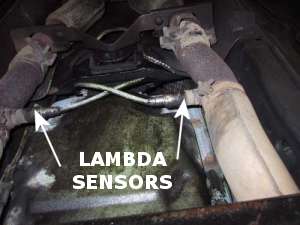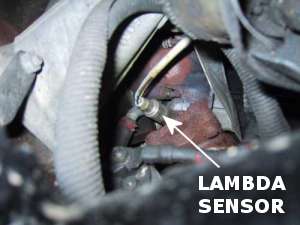The Scorpio is fitted with a 3 way Catalytic Converter (Cat) on all models
except for the 24V which has 2 - one for each downpipe. There are also 2
associated Lambda (Heated Oxygen Sensors) mounted before and after each Cat. The
first one measures the amount of Oxygen in the exhaust gas and is used by the
EEC-V to adjust the mixture between rich and lean and the other monitors the
efficiency of the Cat but is not used by the EEC-V.
How the Catalytic Converter works
There are millions of cars on the road that are potential sources of air
pollution. In a major effort to reduce vehicle emissions, carmakers have
developed an interesting device called a catalytic converter, which treats the
exhaust before it leaves the car and removes a lot of the pollution.
Pollutants Produced the Engine
In order to reduce emissions, modern cars have been designed to carefully
control the amount of fuel they burn. The goal is to keep the air-to-fuel ratio
very close to the "stoichiometric" point, which is the calculated ideal ratio of
air to fuel. Theoretically, at this ratio, all of the fuel will be burned using
all of the oxygen in the air. [For petrol, the stoichiometric ratio is about
14.7 to 1, meaning that for each pound of fuel, 14.7 pounds of air will be
burned. The fuel mixture actually varies from the ideal ratio quite a bit during
driving. Sometimes the mixture can be "lean" (an air-to-fuel ratio higher than
14.7); and other times the mixture can be "rich" (an air-to-fuel ratio lower
than 14.7).]
The main emissions of a car engine are:
 | Nitrogen gas: Air is 78 percent nitrogen gas, and most of this passes right
through the car engine. |
 | Carbon Dioxide: This is one product of combustion. The carbon in the fuel
bonds with the oxygen in the air. |
 | Water vapor: This is another product of combustion. The hydrogen in the fuel
bonds with the oxygen in the air. |
These emissions are mostly benign (although carbon dioxide emissions are
believed to contribute to global warming), however because the combustion
process is never perfect, some smaller amounts of more harmful emissions are
also produced in car engines:
 | Carbon monoxide: A poisonous gas that is colorless and odorless. |
 | Hydrocarbons or volatile organic compounds (VOC's): Produced mostly from
unburned fuel that evaporates. Sunlight breaks these down to form oxidants,
which react with oxides of nitrogen to cause ground level ozone, a major
component of pollution. |
 | Oxides of nitrogen: Contributes to smog and acid rain, and also causes
irritation to human mucus membranes. |
These are the three main regulated emissions, and also the ones that
catalytic converters are designed to reduce.
How Catalytic Converters Reduce Pollution
Most modern cars are equipped with three-way catalytic converters. "Three-way"
refers to the three regulated emissions it helps to reduce - carbon monoxide,
unburnt hydrocarbons and nitrogen oxide molecules. The converter uses two
different types of catalysts, a reduction catalyst and an oxidization catalyst.
Both types consist of a ceramic structure coated with a metal catalyst, usually
platinum, rhodium and/or palladium. The idea is to create a structure that
exposes the maximum surface area of the catalyst to the exhaust stream, while
also minimising the amount of catalyst required (they are very expensive).
There are three main types of structures used in catalytic converters - ceramic
honeycomb, metal plate and ceramic beads (now almost obsolete) - the Scorpio
like most cars today use a ceramic honeycomb structure.
The Reduction Catalyst
The reduction catalyst is the first stage of the catalytic converter. It
uses platinum and rhodium to help reduce the nitrogen oxide emissions. When such
molecules come in contact with the catalyst, the catalyst rips the nitrogen atom
out of the molecule and holds on to it, freeing the oxygen in the form of O2.
The nitrogen atoms bond with other nitrogen atoms that are also stuck to the
catalyst, forming N2.
The Oxidization Catalyst
The oxidation catalyst is the second stage of the catalytic converter. It
reduces the unburned hydrocarbons and carbon monoxide by burning (oxidizing)
them over a platinum and palladium catalyst. This catalyst aids the reaction of
the CO and hydrocarbons with the remaining oxygen in the exhaust gas.
The Control System
The third stage is a control system that monitors the exhaust stream, and uses
this information to control the fuel injection system. There is a heated oxygen
sensor (also called a Lambda Sensor) mounted upstream of the catalytic
converter, meaning it is closer to the engine than the converter. This sensor
tells the EEC-V PCM how much oxygen is in the exhaust. The EEC-V can increase or
decrease the amount of oxygen in the exhaust by adjusting the air-to-fuel ratio.
This control scheme allows the EEC-V to ensure that the engine is running at
close to the stoichiometric point, while also making sure that there is enough
oxygen in the exhaust to allow the oxidization catalyst to burn the unburned
hydrocarbons and carbon monoxide.
Other Ways to Reduce Pollution
The catalytic converter does a great job of reducing pollution, but there is
room for improvement. One of the catalytic converter's biggest shortcomings is
that it only works at a fairly high temperature. When you start your car cold,
the catalytic converter does almost nothing to reduce the pollution in your
exhaust. This is an important note when taking your car for its MOT - make sure
that it has had a good steady run to heat up the Cats to working temperature or
you could fail your emissions test.
One simple solution to this problem is to move the catalytic converter closer to
the engine. This means that hotter exhaust gases reach the converter and it
heats up faster, but this may also reduce the life of the converter by exposing
it to extremely high temperatures. Most carmakers position the converter under
the front passenger seat, far enough from the engine to keep the temperature
down to levels that will not harm it.
Preheating the catalytic converter could be a good way to reduce emissions using
electric resistance heaters. Unfortunately, the 12-volt electrical systems on
most cars just doesn't provide enough energy or power to heat the catalytic
converter fast enough. Most people won't wait a few minutes for the catalytic
converter to heat up before starting their car. Electric/Fuel Hybrid cars that
have big, high-voltage battery packs can provide enough power to heat up the
catalytic converter very quickly which contributes to their green claims of
lower emissions.
The Scorpio Cats form part of a relatively complex exhaust arrangement and can
be expensive to replace at £300 apiece plus installation so well worth getting
them checked by an emission test before purchase of a new vehicle.
 |
 |
| The rear most Lambda sensors are not used to adjust the engine
mixture but simply to identify the performance of the Catalytic Converters. In
ideal conditions they should show a constant output indicating that the Cats are
working as intended. Ripple which mirrors the output of the pre-CAT sensors
indicates Cats that are starting to fail. |
The front sensors (pre-CAT) monitor the engine mixture and
report back to the EEC-V which then adjusts the mixture accordingly. Cats work
best when the mixture varies between weak and rich every few seconds. |
There is an excellent article on Lambda Sensors
Here
A lower cost supplier of Cats and Lambda sensors
can be found at
http://www.cats-direct.com/
Prices range from £158+vat for the 2.3, £185+vat for the2.9 24V and £207+vat
for the 2.0 16V. Lambda sensors (4 wire) are around £25+vat.

![]()
